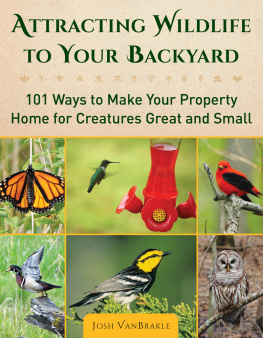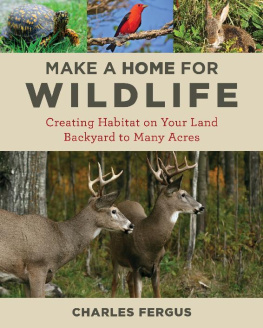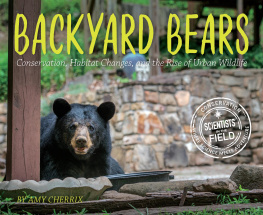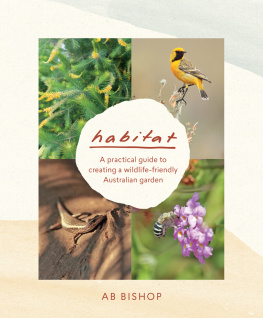My Backyard Jungle

My Backyard Jungle

James Barilla
The Adventures of an
Urban Wildlife Lover
Who Turned His Yard into
Habitat and Learned to
Live with It

Published with assistance from the foundation established in memory of Philip Hamilton McMillan of the Class of 1894, Yale College.
Copyright 2013 by James Barilla.
All rights reserved.
This book may not be reproduced, in whole or in part, including illustrations, in any form (beyond that copying permitted by Sections 107 and 108 of the US Copyright Law and except by reviewers for the public press), without written permission from the publishers.
Yale University Press books may be purchased in quantity for educational, business, or promotional use. For information, please e-mail sales.press@yale.edu (US office) or sales@yaleup.co.uk (UK office).
Designed by James J. Johnson.
Set in type by Integrated Publishing Solutions.
Line woodcut art courtesy of The Florida Center for Instructional Technology; http://etc.usf.edu/clipart.
Printed in the United States of America.
ISBN 978-0-300-18401-3
Catalogue records for this book are available from the Library of Congress and the British Library.
This paper meets the requirements of ANSI/NISO Z39.481992 (Permanence of Paper).
10 9 8 7 6 5 4 3 2 1
To Nicola, Brook, and Beatrice, my fellow backyard enthusiasts
Contents

Acknowledgments
This book could not have been written without the generosity, indulgence, knowledge, and inspiration of many people, only some of whom appear in the book. I am deeply grateful to all who shared their time and stories with me. In a select instance or two, the exact circumstances and identity of some sources have been altered to preserve anonymity. The Provosts Office at the University of South Carolina provided essential support for completing much of the requisite travel. I am also grateful for the support of my colleagues at the University of South Carolina, who listened patiently to my incessant chattering about squirrels and monkeys and contributed many stories of their own. In Delhi, Ashwani Bazaz provided a welcome sanctuary from the urban bustle at the aptly named Tree of Life and helped immensely with the logistics of my explorations. J. P. Sharma at Wild Frontiers was also instrumental in helping me find my way through the city. In Brazil, Jeri Pollack, Yara Castro Roberts, and Esther Ribeiro made tracking down Niterois tamarins possible, while Vinicius Goulart, Aryanne Clyvia, Leonardo Oliveira, and Luis Paulo Ferraz all helped shape my understanding of the complexity of Brazils environment. At Yale University Press, Jean Thomson Blacks enthusiasm for the project was indispensable. Early on, she helped clarify my thinking about the structure of the book and how these different strands of narrative could all fit together. I truly appreciated the help of Laura Jones Dooley, who skillfully polished my prose and suggested ways to tame some of the more convoluted passages. My sincerest appreciation goes to my agent, Wendy Strothman, and her assistant, Lauren MacLeod, who served as expert guides from the earliest stages of the publication process. And finally, my enormous thanks to my family, who with great good humor, curiosity, and forbearance allowed this experiment to take place in their backyard.
My Backyard Jungle
1
Certified

FACT: Twenty-two percent of endangered plant species are found in large metropolitan areas in the United States. Sixty-seven federally listed species are found in the San Francisco Bay area, fifteen around New York City.
This story starts with a move. Actually, yet another move, from the woodsy shores of Lake Michigan to the capital city of South Carolina. This after a sizable sojourn in the redwood country of Northern California and, before that, a stint of several winters in Vermont. My wife, Nicola, is English, and we began our connubial life as renters in a damp Yorkshire city. Weve always been renters. Our new place, a brick house in a leafy neighborhood of Columbia, South Carolina, is the first place with our names on the deed, a fact that has a certain heft to it, as if this document comes not with strings attached but with roots, the delicate white tendrils that sprout from a cutting in a windowsill jar, waiting to take hold.
Rentals always have a temporary air about them, a sense that theres no point in planting anything out back because you wont be around to see it bloom. This house feels different. We could create something here. And I have a long list of things I want to create. I want to taste the fruit of a garden I had tended thats one fantasy, creating a little patch of pastoral bliss back there. I dream of creating habitat for wildlife out there, too, a miniature wilderness in our own backyard. I want our yard to be the kind of place where my kids can catch grasshoppers by day and fireflies at night, where they can dig up potatoes and pick strawberries. The yard I imagine will be interesting and alive.
What I really want, I suppose, is to feel as if I have some small way of pushing back the tide of bad news that seems to arrive every day: the menace of a changing climate, bats dropping dead in their caves, frogs dying, coral reefs disappearing. Ive got two little kidsIm not interested in apocalypse. I want a different story. I want to learn how to coexist with other species, to be able to look out the window and see at least the glimmer of an alternative to extinction. In the parlance of those who study this kind of thing, I have become a stakeholder.
After the moving truck departs from the curb, leaving us with two children under the age of three and boxes stacked to the ceiling in every room, the extent of our dislocation begins to sink in. You can imagine the scene: two brand-new homeowners standing in the front lawn with the kids clamped tight, looking around as if for the first time. They take in the sidewalk that looks like pita bread baking in the noonday sun. They see a palm tree slouching in the distance, hear the cicada trill rising to a fiendish crescendo overhead. You can see them thinking, Where on earth are we? What on earth have we done?
Maybe thats what inspires me to certify our backyard as wildlife habitat: the idea that creating habitat can help us feel at home, as if we belong in this ecological community about which we know so little. Creating habitat in the backyard means learning where wildlife likes to live and forage, which in turn means understanding the climate, the soil, the interplay of sun and shade. Im thinking there will be books to read and stones to turn over and holes to dig, plants to nurture and uproot, a mix of field research, grunt work, and serendipity. It sounds like the kind of project Ive been hankering after for years.
Theres more to the appeal of certifying
Next page











